Summer 2013 - The Mill Hill Missionaries
Summer 2013 - The Mill Hill Missionaries
Summer 2013 - The Mill Hill Missionaries
Create successful ePaper yourself
Turn your PDF publications into a flip-book with our unique Google optimized e-Paper software.
2<br />
<strong>Summer</strong> <strong>2013</strong>
Deep in his heart for us,<br />
<strong>The</strong> wound of love he bore,<br />
That love wherewith<br />
he still inflames<br />
<strong>The</strong> hearts that<br />
him adore.<br />
Contents<br />
Page 3 Editorial.<br />
Page 5 A Man of Faith and Vision.<br />
Page 8 Remembering Scots Pioneer<br />
MHM’s in Uganda.<br />
Page 12 ‘Karunapuram’: Place of<br />
Christian Compassion.<br />
Page 15 From i-Pad to ‘I AM’.<br />
Page 17 In the Land of the Fiery<br />
Mountain.<br />
Page 21 Obituaries.<br />
Page 22 Young Indian MHM’s tell<br />
their stories.<br />
Page 23 Fr Brian Ahern mhm RIP.<br />
Page 26 Our Scots MHM Jubilarians.<br />
Fr. Bill Tollan mhm,<br />
Editor<br />
Editorial<br />
Called to be<br />
missionary<br />
disciples<br />
Sacred Heart of Jesus, by Pompeo Batoni.<br />
“Together let us pause to contemplate the pierced heart<br />
of the Crucified One ... <strong>The</strong> very core of Christianity is expressed in the<br />
heart of Jesus; in Christ the revolutionary ‘newness’ of the Gospel<br />
is completely revealed and given to us: the Love that saves us and<br />
even now makes us live in the eternity of God.”<br />
Pope Benedict XVI<br />
Acknowledgments<br />
Contributors:<br />
Fr T. De Deckere mhm<br />
Fr B. Fox mhm<br />
Frs Suresh Raj, Kocherla, N. Abba<br />
Photo Credits:<br />
B.Fox mhm;<br />
J. Fox;<br />
A. Eppink<br />
Frs Suresh Raj, Kocherla, N. Abba<br />
MH Archives<br />
Cover photos:<br />
Front cover: Women’s work ?,<br />
Malawi.<br />
Back cover: Wee pals, Kenya.<br />
St. Joseph’s Advocate<br />
is the magazine of the <strong>Mill</strong> <strong>Hill</strong> <strong>Missionaries</strong> in<br />
Scotland, published from St. Joseph’s House,<br />
30 Lourdes Avenue, Cardonald,<br />
Glasgow G52 3QU.<br />
Tel: 0141 883 0139.<br />
Email: tollanmhm@yahoo.co.uk<br />
Registered Charity Number: SCO39809<br />
Produced by:<br />
Burns Morrison Print Management Ltd.,<br />
Caledonia Business Centre,<br />
Thornliebank Industrial Estate, Glasgow G46 8JT<br />
Tel: 07799 645 420<br />
Email: sales@burnsmorrison.co.uk<br />
We have all been much<br />
heartened by the first<br />
words and actions of<br />
our new Holy Father,<br />
Pope Francis. Soon he<br />
will be setting-off for<br />
the World Youth Day<br />
in Rio de Janeiro, and<br />
among other places he<br />
will visit the great shrine<br />
to Our Lady of Aparecida. We can be sure<br />
that he will confirm in their faith the young<br />
people gathered from all over the world, and<br />
encourage them to be active witnesses of the<br />
Gospel to the world.<br />
In 2007 the Bishops of Latin America<br />
gathered in Brazil at Aparecida to plan a new<br />
‘continental mission.’ This great conference<br />
was the successor to earlier conferences held<br />
at Medellin (Colombia), Puebla (Mexico), and<br />
Santo Domingo - each of which produced<br />
great documents that have influenced the<br />
development of the post-Vatican II Latin<br />
American Church. <strong>The</strong> main architect of<br />
the Aparecida document was the Cardinal<br />
2<br />
3
Archbishop of Buenos Aires, now<br />
Pope Francis. In this document a fivepoint<br />
plan is outlined and developed:<br />
i. We must begin with establishing a<br />
strong personal relationship with<br />
Jesus Christ.<br />
ii. To be a Catholic is to be a<br />
Missionary Disciple.<br />
iii. Formation of Missionary Disciples<br />
is central to the renewal of the<br />
Church.<br />
iv. Every Catholic and every Catholic<br />
organization must be imbued<br />
with the spirit of Service.<br />
v. We must think globally and act<br />
locally.<br />
Basilica of Our Lady of Aparecida.<br />
In a concluding message from the<br />
Aparecida Conference the Bishops<br />
expressed their belief and hope that<br />
the Church in Latin America will be:<br />
• A life-filled Church, faithful and<br />
credible, which is nourished on the<br />
Word of God and the Eucharist;<br />
• A Church of Christians filled<br />
with the joy and conviction of<br />
Missionary Disciples of Jesus Christ;<br />
• A Church of Christians who are<br />
stewards of creation.<br />
Addressing the national directors<br />
of the Pontifical Missionary Societies<br />
in Rome on May 17th, Pope Francis<br />
said, “We are all simple tools, but<br />
important ones; we have received<br />
the gift of faith not to keep it<br />
hidden, but to spread it, so that it<br />
can illuminate the path of so many<br />
brothers and sisters.” He went on<br />
to speak of our being willing “to<br />
be instruments of God’s mercy, his<br />
tenderness, his love for every man<br />
and every woman, especially the<br />
poor, the excluded, the far off. And<br />
this, for every Christian, for the<br />
whole Church, is not an optional<br />
mission, but an essential one.”<br />
Pope Francis concluded by warning<br />
us against the temptation to ‘close in<br />
on ourselves, worried about our own<br />
problems,’ and being forgetful of the<br />
‘universal mission’ of the Church.<br />
In other words, the Gospel message<br />
must be proclaimed to all - in word<br />
and in deed - at home and abroad.<br />
We must not be pre-occupied by<br />
the troubles experienced here in our<br />
Church in Scotland.<br />
I think we can all expect to hear<br />
much more from Pope Francis on the<br />
subject of ‘Missionary Discipleship.’<br />
In the present issue of the<br />
‘Advocate’ there are many examples<br />
of people who heard the call to be<br />
‘Missionary Disciples’ - our early<br />
Scots MHMs, and our young African<br />
and Asian MHM’s who are their<br />
successors. May their example help us<br />
all to be zealous ‘missionary disciples’<br />
according to the circumstances of our<br />
own lives<br />
A Man of Faith<br />
and Vision<br />
On March 26th this year, at an<br />
elaborate ceremony in the magnificent<br />
Liverpool Town Hall, St Joseph’s<br />
Hospice Association (known as<br />
JOSPICE) was granted the freedom of<br />
the City of Liverpool. <strong>The</strong> Lord Mayor,<br />
Councillor Sharon Sullivan, paid<br />
tribute to the work of JOSPICE over the<br />
last 50 years, in providing “loving and<br />
compassionate care to people of any<br />
faith and those without faith in the<br />
last weeks of their lives.” Admission<br />
to the Freedom Roll was the highest<br />
honour the city could bestow, she said,<br />
and was richly deserved.<br />
Jospice was founded by <strong>Mill</strong> <strong>Hill</strong><br />
Missionary Fr Francis O’Leary. Born in<br />
Crosby in 1931, he was ordained at <strong>Mill</strong><br />
<strong>Hill</strong> in 1956, and appointed to study<br />
at Glasgow University, graduating in<br />
1960. Contemporaries at University<br />
were Fr Pat McDonald (who died in<br />
2000) and Fr Bill Tollan. Though they<br />
were ‘local boys’ Fr Frank seemed to<br />
4 5
have far more friends in Glasgow<br />
than themselves. <strong>The</strong>se friendships<br />
he maintained in the years ahead,<br />
and many of them were of great help<br />
in the early years of Jospice.<br />
After graduation, Fr O’Leary<br />
was appointed to the diocese of<br />
Rawalpindi, Pakistan. <strong>The</strong>re he<br />
taught in St Mary’s School for<br />
Boys, while helping in the parish<br />
in Westridge. On the voyage out to<br />
begin his work in Pakistan he had<br />
met Margaret and Peter Seymour-<br />
Eyles who were on their way to Assam<br />
in India. <strong>The</strong>y showed an interest<br />
in the work he would be doing in<br />
Pakistan, and gave him an invitation<br />
to visit them. Two years later he was<br />
able to accept this invitation. His<br />
route took him through Calcutta,<br />
so on the return journey he visited<br />
the Sisters of Mother Teresa. He was<br />
deeply moved by the great poverty he<br />
saw, and filled with admiration for the<br />
way the Sisters were responding to the<br />
needs of the poorest of the poor. At the<br />
Sisters’ Hospice at the Kalighat Temple<br />
he took a photograph of a dying man<br />
who was being cared for by the Sisters.<br />
<strong>The</strong> image of that man remained with<br />
Fr Frank for the rest of his life, and<br />
was the inspiration that led to the<br />
founding of Jospice.<br />
Later that year, Fr Frank learned of<br />
a Mrs Jacob, a stroke victim, who had<br />
been completely abandoned by her<br />
family. Since no hospital would accept<br />
her, Fr Frank arranged for her to be taken<br />
to an unused outhouse at St Mary’s<br />
Catholic Church in Rawalpindi. This<br />
was cleared out and made habitable,<br />
and there she was lovingly cared for<br />
by the local Franciscan <strong>Missionaries</strong><br />
of Mary. <strong>The</strong> date Mrs Jacob had been<br />
taken to the outhouse was November<br />
19th, Feast of St Elizabeth of Hungary,<br />
Fr Francis O’Leary.<br />
and Patroness of Nurses. On that day<br />
Fr O’Leary had said to a parishioner:<br />
“We must remember this day because<br />
it might be important to us one day.”<br />
This date is still celebrated by Jospice<br />
as ‘Founder’s Day.’<br />
It became clear there was need for a<br />
purpose-built hospice for people with<br />
incurable illnesses and for the povertystricken<br />
sick. A committee was set<br />
up, and appeals made to people in<br />
Pakistan and later in Britain to help<br />
build the hospice. By October 1963<br />
£8,000 had been collected and work<br />
was begun on the building. A generous<br />
grant came from the German Bishops<br />
to help complete the work, and the<br />
building was opened in November<br />
1964 by Cardinal Alfrink of Utrecht.<br />
<strong>The</strong> single-story building had two<br />
20-bed wards and was dedicated to St<br />
Joseph.<br />
Like the founder of the <strong>Mill</strong> <strong>Hill</strong><br />
<strong>Missionaries</strong>, Cardinal Vaughan,<br />
Fr O’Leary maintained a great<br />
devotion to St Joseph, entrusting<br />
to him all the financial affairs of<br />
Jospice. Mother Teresa had written<br />
to him, “Don’t worry about the<br />
money - God will provide.” This<br />
has remained the philosophy<br />
of Jospice. Repeatedly, when<br />
there was no money to pay the<br />
bills, and the whole enterprise<br />
seemed doomed, Fr Frank’s faith<br />
was rewarded by unexpected<br />
donations. In 1972 there was an<br />
overdraft of £3,000; the bank<br />
manager expressed his concern. Fr<br />
Frank went into a nearby Church<br />
to pray to St Joseph. Returning to<br />
the office he found an anonymous<br />
donation of almost £3,000. <strong>The</strong> next<br />
week the bank manager demanded<br />
that the overdraft of £500 be cleared.<br />
That day a cheque for £500 arrived in<br />
the post.<br />
In 1966 a committee was set up<br />
in Liverpool to increase fund-raising<br />
activities. A room was rented in the<br />
Liverpool Diocesan offices. <strong>The</strong> work<br />
expanded, and the first hospice was<br />
opened in Colombia, South America,<br />
in 1966. Another was opened at<br />
Negritos, Peru, in 1970. In 1975<br />
another <strong>Mill</strong> <strong>Hill</strong> Missionary, Fr Frank<br />
Smith, who had trained as a nurse,<br />
began work on a rural health clinic<br />
in the slums of Guayaquil, Ecuador.<br />
Fr Frank was able to combine his<br />
pastoral work with promoting health<br />
care among the very poor of the Isla<br />
Trinitaria, just outside the city of<br />
Guayaquil. Later, other hospices and<br />
health centres were opened in Peru,<br />
Guatemala, Honduras, and Mexico.<br />
In 1973, Fr O’Leary featured in the<br />
famous Eamon Andrews’ TV show,<br />
This old man, photographed in Calcutta<br />
by Fr O’Leary, and Mrs Jacob, the first<br />
patient in Rawalpindi, provided the<br />
inspiration on which St Joseph’s Hospice<br />
Association is founded.<br />
‘This is Your Life.’ <strong>The</strong> programme<br />
drew the highest TV ratings for that<br />
week. Many of the people involved in<br />
the Jospice story were brought together<br />
for the occasion. <strong>The</strong> following year<br />
a hospice was opened in Thornton,<br />
near Liverpool, and this became the<br />
headquarters for Jospice International.<br />
In 1996 Fr Frank was awarded the MBE<br />
in the Queen’s birthday honours.<br />
From the beginning of the year<br />
2000 Fr O’Leary had not been well. In<br />
the summer he was taken to hospital<br />
after a suspected heart attack. He died<br />
on October 4th, Feast of St Francis. On<br />
the occasion of Jospice being granted<br />
the freedom of the City of Liverpool,<br />
Fr O’Leary’s cousin, Archbishop<br />
Vincent Nichols of Westminster,<br />
thanked God for all who have worked<br />
and volunteered so generously to<br />
realise the vision of Jospice. “With the<br />
powerful help of St Joseph’s prayers”<br />
he wrote, “may Jospice continue to<br />
serve our terminally ill brothers and<br />
sisters for many more years to come.”<br />
6<br />
7
Remembering<br />
Scots <strong>Mill</strong> <strong>Hill</strong><br />
Pioneer <strong>Missionaries</strong><br />
in Uganda<br />
On Saturday May 4th the annual<br />
15 mile walk took place from St Simon’s<br />
Church in Partick, along the banks of<br />
the Clyde, to Blantyre - the birthplace<br />
of the great Scottish missionary and<br />
explorer, David Livingstone.<br />
‘Faith, Freedom, Adventure’: these<br />
words appear on a brochure produced<br />
to celebrate the 200th anniversary of the<br />
birth of David Livingstone.<br />
Livingstone died in 1873 in a village<br />
in modern-day Zambia, having<br />
travelled over 46,000 kms - mainly<br />
on foot - throughout vast areas of<br />
unexplored Africa. He was born into<br />
a poor family in Blantyre, worked<br />
14 hours a day in the local cotton<br />
works from the age of 10, and<br />
yet managed to study to prepare<br />
himself for University. <strong>The</strong> local<br />
Catholic priest, Fr Daniel Gallagher<br />
coached the bright young student<br />
in Latin - necessary for University<br />
admission. (Fr Gallagher later founded<br />
the church that became St Simon’s.)<br />
After graduating as a doctor he joined<br />
the London Missionary Society and<br />
began medical missionary work<br />
in what is now Botswana. Soon<br />
however, he undertook the first of<br />
many expeditions, using his skills<br />
as a linguist, navigator, and natural<br />
historian.<br />
By the time of his death, Livingstone<br />
was a national hero - and an inspiration<br />
to many who wished to follow in his<br />
footsteps. He had sought to open<br />
up the ‘dark continent’ - to allow<br />
missionaries and traders to follow, to<br />
eradicate the slave trade and improve<br />
the lives of the indigenous people.<br />
<strong>The</strong> Victorians had no doubts about<br />
the benefits of the Christian religion<br />
and Western civilization. But, unlike<br />
many who followed him, Livingstone<br />
had a deep respect for the local African<br />
people, and would not have approved<br />
of the way the colonial ‘scramble for<br />
Africa’ unfolded.<br />
Fr Herbert Vaughan was filled with<br />
a similar zeal to bring the Gospel<br />
message to Africa. In founding St<br />
Livingstone reading to his young<br />
daughter Anna.<br />
Joseph’s Missionary Society in 1866<br />
he was spurred-on by the zeal of<br />
the various Protestant missionary<br />
societies, and felt it imperative that<br />
Catholics should be no less zealous in<br />
their missionary efforts. As Bishop of<br />
Salford, Vaughan had met the great<br />
explorer Henry Morton Stanley on his<br />
return from Central Africa in 1876.<br />
(Five years earlier Stanley had famously<br />
found Livingstone, allegedly greeting<br />
him with ‘Dr Livingstone, I presume.’)<br />
<strong>The</strong> Bishop was Vice-President of the<br />
Manchester Geographical Society.<br />
He keenly desired that some of his<br />
missionaries should be assigned<br />
to Africa. However, Vaughan was<br />
unimpressed by any boasting about the<br />
growing extent of the British Empire.<br />
Such boasting, he wrote, is “vanity<br />
and weakness...whatever the character<br />
of the conqueror or the intentions of<br />
their government.” His motivation<br />
was rather “to put down the curse of<br />
African slavery and to establish in its<br />
place the voluntary and sweet service<br />
of Our Lord Jesus Christ.”<br />
In 1895 the first group of five<br />
<strong>Mill</strong> <strong>Hill</strong> <strong>Missionaries</strong> arrived in the<br />
Protectorate of Uganda. <strong>The</strong>y were<br />
8<br />
9
welcomed by the mainly French<br />
White Fathers who had begun<br />
missionary work in 1879. A civil<br />
war of 1892 had created the<br />
impression that Roman Catholics<br />
were French, and Protestants were<br />
British. <strong>The</strong> newly-arrived MHM’s<br />
were led by an Englishman, Bishop<br />
Hanlon; the other four included a<br />
Dutchman, an Irishman, and two<br />
Scots - Frs James Prendergast from<br />
Dundee, and Thomas Matthews<br />
from Dumfries. Fr Matthews was<br />
to spend the rest of his life in<br />
Uganda, dying on Easter Sunday<br />
1942. He was the last survivor of<br />
that first group that had made the<br />
arduous journey on foot from the<br />
coast to Kampala. His fellow Scot,<br />
Fr Prendergast, however was dead<br />
within five years of his arrival.<br />
Surviving letters to headquarters<br />
from the missionaries give vivid<br />
descriptions of their journey to their<br />
new mission, and the early years of<br />
the <strong>Mill</strong> <strong>Hill</strong> Mission. <strong>The</strong>ir ‘caravan’<br />
had set out from Mombasa on the<br />
East African coast on June 22nd and<br />
arrived in Kampala, Uganda, on<br />
September 26th. <strong>The</strong>y covered on<br />
average 13 to 14 miles a day, but with<br />
many interruptions on the way. <strong>The</strong><br />
‘caravan’ consisted of over 160 people<br />
- including ‘askaris’ (armed guards),<br />
porters, cooks, tent-boys, guides, etc.<br />
<strong>The</strong>se were recruited with the help<br />
of a local agent, who also procured<br />
a number of donkeys - for carrying<br />
goods and sometimes the missionaries<br />
themselves. Fr Prendergast wrote he’d<br />
been appointed ‘chef de cuisine’ for<br />
the journey, while Fr Matthews was to<br />
First Caravan to Uganda 1895.<br />
Bp Hanlon is seated and Fr James<br />
Prendergast is on the left of the picture,<br />
and beside him is Fr Thomas Matthews.<br />
be in charge of the tents.<br />
Five weeks into the journey Bishop<br />
Hanlon wrote, “During the first three<br />
weeks of our travels from Mombasa we<br />
were nearly roasted, and the skin was<br />
crisped from our faces; during the past<br />
fortnight it has often been scorching<br />
hot during late morning and early<br />
afternoon, and very cold at night and<br />
early morning. During the past week<br />
we have slept nearly every night in a<br />
Scotch mist...We have each a donkey<br />
to ride when we are tired, but for the<br />
most part do our marches on foot...<br />
We are one of the few caravans that<br />
have come so far without losing some<br />
men by death, either from disease or<br />
exposure or wild animals or equally<br />
wild natives of the Interior.” At times<br />
there was a shortage of food and/<br />
or water; other times they had to<br />
negotiate large swamps, or cross big<br />
rivers. Porters were often difficult to<br />
handle, and some disappeared with<br />
their loads. “Of the 160 men who<br />
made up our caravan on leaving the<br />
coast, 26 deserted and caused us great<br />
inconvenience; eleven were left sick<br />
at different stations on the way...three<br />
died, and a fourth was speared to death<br />
by the remorseless Wanandi tribe.”<br />
Two hundred warriors of this warlike<br />
tribe had attacked an advance party of<br />
the caravan of the Protestant Church<br />
Missionary Society (CMS) that was<br />
following the same trail as the MHM<br />
group. All but seven of the 31 porters<br />
were killed. Bishop Hanlon had been<br />
forced by exhaustion and the desertion<br />
of porters to leave behind eleven crates<br />
in charge of an askari. <strong>The</strong> crates were<br />
to be brought on later. Four of these<br />
were abandoned on the road, the rest<br />
were carried by porters who joined up<br />
with the CMS caravan, but were then<br />
ransacked by the Wanandi. Many<br />
valuable items were thus lost.<br />
Arrived at last at their destination,<br />
Fr Prendergast wrote: “By the help of<br />
God and the assistance of the prayers<br />
of all our friends at home, we have<br />
accomplished the task - to journey<br />
on foot for two months and a half<br />
through barren desolate country,<br />
through jungle and swamp, through<br />
the midst of thieves and murderers,<br />
through paths infested by wild beasts<br />
and savage natives. Thanks be to God,<br />
we are all in good health, in spite of<br />
the terrors and dangers we had to pass<br />
through.”<br />
<strong>The</strong> new missionaries soon began<br />
the serious work of establishing new<br />
missions, learning the language, and<br />
laying the foundations for what was to<br />
become the thriving Church of today.<br />
But five years after his arrival, James<br />
Prendergast succumbed to the deadly<br />
black-water fever. Fr Matthews wrote<br />
home of the great energy his colleague<br />
had brought to his missionary work,<br />
how he had mastered the language,<br />
built the great reed Church at Nsambya,<br />
and was much loved by the people.<br />
Great crowds attended his funeral<br />
Mass. “<strong>The</strong>y flocked to the graveyard<br />
from all parts, and amidst the genuine<br />
sobbing and weeping of his loved and<br />
loving people the remains of dear<br />
Fr Prendergast were laid to rest.”<br />
10<br />
11
‘Karunapuram’<br />
a place of Christian<br />
compassion in India<br />
Fr Thaddeus de Deckere is a member of the General Council. Here he<br />
describes a recent visit to his former area of missionary work.<br />
In January of this year I was in<br />
our Training Centre for <strong>Mill</strong> <strong>Hill</strong><br />
<strong>Missionaries</strong> in India. <strong>The</strong> staff had<br />
requested me to give two short<br />
courses to our students there, and<br />
they gave me a warm welcome when<br />
I arrived on 4th of January. <strong>The</strong><br />
Centre is situated at a place called<br />
Karunapuram which is a three hour<br />
bus trip away from the mega-city of<br />
Hyderabad in the state of Andhra<br />
Pradesh After having been in the<br />
over-crowded city for some days it<br />
was a relief to breathe the fresh air of<br />
rural India.<br />
Student outing<br />
on a lake.<br />
Karunapuram is a big campus of<br />
several hundreds of acres in size.<br />
It is home to some 20 educational<br />
institutes as well as institutes for the<br />
care of the sick, the handicapped, a<br />
school for deaf and dumb children,<br />
a leprosarium and a care centre for<br />
those suffering from HIV/AIDS.<br />
Besides that there is outreach to the<br />
poor through social programmes.<br />
<strong>The</strong>se institutes are run by a variety<br />
of religious congregations as well<br />
as the local diocese. Karunapuram<br />
(which means: place of compassion)<br />
is a true oasis for the sick and needy,<br />
and for children and youngsters in<br />
need of good quality education.<br />
It is the realisation of the dream<br />
of an Italian missionary who had<br />
the foresight some 50 years ago<br />
to buy this plot of land which was<br />
considered wasteland on which<br />
nothing would grow. Our <strong>Mill</strong> <strong>Hill</strong><br />
Formation house is situated on the<br />
edge of the campus, right next to the<br />
care centre of HIV/AIDS patients.<br />
At present there are over 50 <strong>Mill</strong><br />
<strong>Hill</strong> students preparing for life as a<br />
missionary. Without much difficulty<br />
I adjusted to the rhythm of the life<br />
of the community, which revolves<br />
around study and manual work<br />
on the one hand, and prayer and<br />
recreation on the other.<br />
It was encouraging to see<br />
how the students are gradually<br />
developing a vision of care for<br />
the world in which we live: sociopastoral<br />
care for the people as<br />
well as care for the environment,<br />
God’s beautiful creation. During<br />
Fr Thaddeus visiting the Fatima Sisters,<br />
founded by MHM Mgr F.X.Kroot.<br />
my stay I witnessed how the student<br />
community undertook a cleaning<br />
drive of the area surrounding the<br />
nearby hospital, removing heaps<br />
of rubbish that visitors and passersby<br />
had carelessly thrown there.<br />
Hopefully the students’ efforts<br />
will contribute to a gradual rise in<br />
environmental awareness, which<br />
is still largely lacking among great<br />
sections of the population.<br />
<strong>The</strong> MHM Formation House in<br />
Karunapuram.<br />
12 13
Students at prayer, India.<br />
<strong>The</strong> courses went well. We<br />
studied the history of the<br />
<strong>Mill</strong> <strong>Hill</strong> <strong>Missionaries</strong> in the<br />
Indian subcontinent, which<br />
began in 1875 with the<br />
arrival by boat of the first<br />
band of four missionaries<br />
in Chennai (Madras). <strong>The</strong><br />
students engaged well also<br />
in the course on Vacation<br />
Discernment which was meant to<br />
help them get a clearer idea of what<br />
God might be calling each one to.<br />
On the last evening of my stay the<br />
students displayed their<br />
talents in a colourful<br />
cultural evening, filled<br />
with skits, jokes, song<br />
and dance. It has been<br />
a worthwhile as well as<br />
a pleasant stay with our<br />
<strong>Mill</strong> <strong>Hill</strong> Community in<br />
MHM meeting in India.<br />
Karunapuram, and I wish both staff<br />
and students God’s richest blessings<br />
as they strive to be a model Christian<br />
Community.<br />
From Ipad to….“I am”<br />
by Bernard Fox MHM, Bamenda, 1st May <strong>2013</strong><br />
Blue skies pushed through the<br />
Cameroon clouds on Friday l9th April<br />
as we gathered in Jakiri, Cameroon for<br />
the priestly ordinations of two young<br />
Cameroonian <strong>Mill</strong> <strong>Hill</strong> missionaries,<br />
Rev Fred NgwangussemYangnyi and<br />
Rev Anthony Emeka. It was for me a<br />
trip down memory lane as I had often<br />
passed through Jakiri when I was<br />
working as a MHM in Mayo Darle in<br />
the 1980s - sometimes transporting<br />
patients from our Health Centre<br />
along the +300 kms journey to the<br />
Catholic hospital at Shisong. <strong>The</strong><br />
Catholic church, perched on a hill<br />
overlooking Jakiri, was built like a<br />
pagoda by a <strong>Mill</strong> <strong>Hill</strong> missionary who<br />
had worked in Malaysia and was full<br />
to capacity as Bishop George Nkuo<br />
and ten MHM priests processed into<br />
it - to be greeted by over 1000 faithful<br />
singing and dancing and thanking<br />
God that He had chosen two young<br />
men from among them to go out as<br />
<strong>Mill</strong> <strong>Hill</strong> missionaries, just as he had<br />
chosen young men from Scotland in<br />
the past to go as His messengers to<br />
Cameroon away back in 1922.<br />
In his homily, bishop George noted<br />
that Frs Fred and Anthony were<br />
children of the iPad/iPhone/iPod<br />
generation. He challenged them to<br />
14<br />
Silver Circle Winners<br />
December 2012: 249 Taylor £25 • 19 McGuire £15 • 203 Joyce £10<br />
December 2012: 257 McQuaid £25 • 146 Hughes £15 • 69 Hamilton £10<br />
January <strong>2013</strong>: 5 Corvi £25 • 148 LLewellyn £15 • 278 Caban £10<br />
February <strong>2013</strong>: 110 Hughes £25 • 27 Burrrows £15 • 143 Hendry £10<br />
March <strong>2013</strong>: 173 Hendry £25 • 96 Lafferty £15 • 24 Doogan £10<br />
April: <strong>2013</strong>: 72 Clynes £25 • 236 Heraghty £15 • 161 Travers £10<br />
May <strong>2013</strong>: 323 O’Sullivan £25 • 241 Denton £10 • 327 Traynor £10<br />
June <strong>2013</strong>: 104 McLaughlin £25 • 144 Gallacher £15 • 19 McGuire £10<br />
Congratulations to them all.<br />
15
help the people to whom they were<br />
being sent not to become enslaved by<br />
the modern gods on offer, symbolised<br />
by the iPad and all that this represents.<br />
Instead, said the bishop, the new<br />
missionaries must help their people<br />
see that only the One who said “I am”<br />
could offer true freedom.<br />
I was inwardly wondering whether<br />
the local people, mostly farmers, had<br />
ever seen an iPad. When we emerged<br />
from the church three hours later<br />
and took my place beside the bishop<br />
and the two newly ordained MHMs I<br />
looked at the battery of photographers<br />
and, sure enough, one of them was<br />
“snapping” away - with an iPad!<br />
Fr Fred will be going to Northern<br />
Uganda, to Panyangara, where Fr<br />
Gerry Hastie spend many happy<br />
years. He will be working in the<br />
same Catholic mission where one<br />
of our young Irish MHMs, Fr Declan<br />
O’Toole, was killed in an ambush after<br />
speaking out against army brutality<br />
during a de-arming operation.<br />
Fr Anthony is appointed to the<br />
diocese of Malindi, on the coast of<br />
Kenya. He will be going to a place<br />
near where St Francis Xavier stopped<br />
off for a few days in 1542 to bury two<br />
soldiers who had died on board the<br />
ship that was taking him to Asia to<br />
preach the Gospel to the people there.<br />
In his homily on 19th March, the<br />
feast of St Joseph, the day he was<br />
installed as the successor to Benedict<br />
XVI, Pope Francis referred to St Joseph,<br />
saying that as St Joseph protected and<br />
cared for Mary and Jesus, so he saw<br />
his role as Bishop of Rome as one of<br />
protecting and caring for the Church.<br />
He went further, challenging all<br />
people, Catholic or not, to care for the<br />
earth and its people. He said:” It means<br />
respecting each of God’s creatures and<br />
respecting the environment in which<br />
we live. It means showing loving<br />
concern for each and every person,<br />
especially children, the elderly, those<br />
in need who are often the last we<br />
think about.”<br />
Surely this is a wonderful summary<br />
of the Good News of Jesus…the Good<br />
News that we are invited to welcome:<br />
as God respects and cares for us so must<br />
we care and respect and love everyone<br />
and everything He has created.<br />
This is the message that our newly<br />
ordained missionaries will be taking<br />
to Malindi and Karmamoja - but it is<br />
also the message that we are called to<br />
live in Motherwell and Kilmarnock,<br />
Clarkston and Cardonald!<br />
In the Land of the<br />
Fiery Mountain<br />
From small beginnings the Church in Cameroon has grown dramatically; a<br />
memoir written in his retirement by Bishop John Campling recalls the early days.<br />
“About 8.00 at night the Captain<br />
called me to come up to the bridge.<br />
Pointing straight ahead he said,<br />
‘Look, there is your future now.’ On<br />
the distant horizon there was a large<br />
red glow like the setting of the sun. It<br />
was the burning Mount Cameroon.”<br />
So wrote Mgr John Campling in a<br />
memoir recalling his arrival with three<br />
other young MHM’s in the new MH<br />
mission of Cameroon. It was March<br />
1922. John Campling came from<br />
Partick in Glasgow and had started<br />
his missionary work in Uganda. He<br />
had been appointed ‘Prefect Apostolic’<br />
to lead the first group of MHM’s to<br />
what had been until 1914 German<br />
Kamerun. At the outbreak of the First<br />
World War the British and the French<br />
took control of the country, the British<br />
part effectively being administered<br />
from Nigeria.<br />
<strong>The</strong> four missionaries had travelled<br />
by boat along the coast of West Africa,<br />
calling at Freetown in Sierra Leone,<br />
and then at Lagos and Calabar in<br />
Nigeria. <strong>The</strong> Holy Ghost Fathers in<br />
Calabar had mentioned that Mount<br />
Cameroon was volcanic and liable to<br />
erupt periodically, but the <strong>Mill</strong> <strong>Hill</strong><br />
men had taken little note of this. Now<br />
their boat drew nearer to the great<br />
mountain. “What a sight it was” wrote<br />
Bishop Campling. “... over 15,000 feet<br />
Results of Annual Prize Draw June 1st <strong>2013</strong><br />
1st Prize: £200 K. Brown Motherwell<br />
2nd Prize: £100 M. Hagan Ayr<br />
3d Prize: £50 G. McKeown Spears Town, Co Donegal<br />
£10 Prizes: B.McGee; McCowan; B.Carey; G.Entrican; K.McColgan<br />
<strong>The</strong> ‘outstanding’ pioneer catechist<br />
Matthias Efiem (centre, wearing his<br />
Papal Medal, standing beside Fr Bill<br />
Congratulations to them all.<br />
Tollan) on occasion of his Golden Wedding.<br />
16 17
high, on it were two craters belching<br />
forth a fiery stream of lava which was<br />
a mile broad and flowed down for five<br />
miles into the sea. Plantations, houses,<br />
and even the fish in the sea were<br />
destroyed. <strong>The</strong> burning lava thrown<br />
up in the air was all sizes, forms and<br />
colour, and some of the fiery material<br />
was the size of a large table. It was a<br />
sight never to be forgotten.”<br />
<strong>The</strong> young missionaries were<br />
understandably apprehensive about<br />
this land of fire to which they were<br />
heading. “It was late when we retired<br />
with not too cheerful thoughts to our<br />
cabins.” Next day they reached Bota,<br />
the small port near the town of Victoria.<br />
After coming ashore by launch they<br />
made their way to Bota Mission - built<br />
by the German missionaries who had<br />
all been expelled at the outbreak of<br />
the First World War. <strong>The</strong>y found a<br />
fine Church, a presbytery, and various<br />
out-houses - all well-built, and cared<br />
for in the absence of the Germans by<br />
the catechists. Outstanding among<br />
the latter was Matthias Efiem who<br />
was to spend the rest of his long life<br />
in the service of the Church working<br />
alongside our missionaries. One of<br />
the European officials told Bishop<br />
Campling how the Catechists had<br />
edified everyone by their faith and<br />
loyalty to their work. Every Sunday for<br />
seven years, in the absence of a priest,<br />
they held devotions in the Church and<br />
gave instruction in the faith.<br />
From Bota the erupting craters on<br />
the mountain were not visible, though<br />
at night a great ominous glow would<br />
light up the sky. Within a month the<br />
eruptions ceased, “and mighty glad we<br />
all felt.” <strong>The</strong> Germans had established<br />
two other Missions higher up the<br />
mountain slope, - Bonjongo - about<br />
6 miles away, and still higher - Sasse -<br />
<strong>The</strong> old German Church at Bonjongo.<br />
eight miles further. Again, there were<br />
good buildings - including a primary<br />
school which was run by the head<br />
catechist. <strong>The</strong> German colonizers<br />
had established extensive oil-palm<br />
plantations, giving employment to<br />
many people, and attracting labourers<br />
from great distances. In fact, the<br />
local Bakweri people were heavily<br />
outnumbered in the plantations by<br />
people of other tribes. Hence the<br />
importance of Pidgin English - the<br />
‘lingua franca’ for all the tribes - and<br />
soon adopted by the missionaries as<br />
the language for Christian instruction.<br />
Within a few years of the arrival of the<br />
<strong>Mill</strong> <strong>Hill</strong> <strong>Missionaries</strong> the numbers of<br />
Catholic Christians increased rapidly.<br />
Much of the increase was attributable<br />
to the efforts of the catechists in the<br />
workers’ ‘camps’ scattered throughout<br />
the plantations. Bishop Campling<br />
wrote of an assistant teacher in Sasse<br />
taking time-off to spend some weeks<br />
labouring in the plantations to obtain<br />
money to pay his father’s tax. On his<br />
return he said he had taught many of<br />
his fellow-labourers all the ‘doctrine’ he<br />
knew; there was need now for a good<br />
Catechist to give fuller instruction<br />
and prepare them for Baptism. <strong>The</strong><br />
departed German missionaries had<br />
left yet another valuable legacy that<br />
greatly assisted the rapid growth of the<br />
Church: they had recognised the rich<br />
musical ability of the people. Bishop<br />
Campling wrote, “<strong>The</strong>ir singing of<br />
plain chant and of polyphonic music<br />
also, was a pleasant surprise.”<br />
Campling had made his<br />
headquarters in Bonjongo, from where<br />
on a clear day there was a wonderful<br />
view of the bay below and over 50 miles<br />
away the island of Fernando Po - a<br />
perfectly-shaped volcanic cone. About<br />
a year after their arrival, a very severe<br />
earthquake shook the house shortly<br />
after midnight. Next day further<br />
alarming tremors were experienced. A<br />
boy working in the house was thrown<br />
to the ground, and one of the priests<br />
came rushing from the Church fearing<br />
the building was falling down. “But<br />
that was just the beginning; shocks<br />
occurred daily, hourly, and at times<br />
two or three in the hour...there was a<br />
sound like thunder down in the earth,<br />
a rattling of the iron roof, the creaking<br />
of the stairs, a shaking of doors and<br />
windows, and the queer oscillation of<br />
the bed, floor and ground; even the<br />
birds were disturbed and twittered in<br />
alarm.” It seemed as if “a powerful<br />
explosive force was seeking an outlet,<br />
and that it may happen just where<br />
we are. It persisted for a full month<br />
and was indeed a most harrowing<br />
experience. It was the best retreat I ever<br />
made.”<br />
Until then the new missionaries had<br />
confined their work to the existing<br />
missions near the coast. But their<br />
mission was to be to all the people of<br />
what was now British West Cameroon.<br />
<strong>The</strong> Germans had started missions in<br />
a few other places further inland. <strong>The</strong><br />
furthest-away of these was near Kumbo<br />
- 150 miles north. John Campling<br />
A young Fr Campling.<br />
<strong>The</strong> Fon on his throne, Cameroon.<br />
Fon’s warriors at his Palace.<br />
18 19
set off for Kumbo on a long trek on<br />
foot that took him through the thick<br />
equatorial forest and then up into the<br />
Bamenda Highlands. Along with him<br />
went a catechist, cook, and fourteen<br />
porters - to carry all that was needed<br />
for the journey, cooking utensils, Mass<br />
box, clothes, table, chairs, oil-lamp,<br />
etc. <strong>The</strong> length of the daily marches<br />
varied from nine to 27 miles; they set<br />
out before sunrise before the sun got<br />
really hot.<br />
One day they reached a large<br />
plantation, and the manager invited<br />
Mgr. Campling to stay for lunch<br />
and tea. Nearby was a large empty<br />
store-house. “<strong>The</strong> kindly manager<br />
said he could send word around for<br />
the Catholics to gather there if I so<br />
agreed. He then called his drummer<br />
and ordered him to send the necessary<br />
message. This he did from the<br />
verandah by tapping his rat-a-tat on<br />
his drum.” At the appointed time the<br />
Catholics had duly assembled, and the<br />
priest was kept busy with confessions<br />
for the next few hours.<br />
<strong>The</strong> journey continued for many<br />
days, through thick forest and across<br />
streams and rivers. Some of the rivers<br />
they had to cross by suspensionbridges<br />
made from ‘bush rope’ made<br />
from the abundant creepers that grew<br />
on the trees. Crossing such bridges was<br />
a scary experience, especially when the<br />
fibres had begun to disintegrate. On<br />
one occasion the party had made the<br />
crossing as darkness was falling. It was<br />
only next day in the daylight that they<br />
saw how near to breaking-point the<br />
rope-bridge was.<br />
<strong>The</strong> forest gradually gave way to<br />
grassland as the travellers climbed<br />
up into the highlands. At Bali they<br />
found a lively Christian community,<br />
with a good catechist and a well-built<br />
bush church. <strong>The</strong> people were eager<br />
to receive the Sacraments after such<br />
a long interval. <strong>The</strong> local ‘Fon’ (or<br />
King) received them at his palace. He<br />
was seated on his elaborately carved<br />
throne, an elephant’s tusk as his<br />
footstool. That night Mgr Campling<br />
was awakened by the sound of horns<br />
being blown at about 3.00 am. At<br />
breakfast he was informed that the<br />
Fon’s warriors had been summoned<br />
to make an attack on a neighbouring<br />
tribe.<br />
After many more days of marching<br />
the party reached their destination<br />
of Kumbo where there was a wellestablished<br />
Mission Station begun by<br />
the Germans. <strong>The</strong> journey had given<br />
John Campling an overview of the task<br />
ahead of the <strong>Mill</strong> <strong>Hill</strong> <strong>Missionaries</strong> in<br />
this part of Cameroon. He began to<br />
lay his plans for the future. However,<br />
two years after his arrival in Cameroon<br />
he was to return to his original area<br />
of missionary work - in Uganda, but<br />
this time as Bishop. Before leaving<br />
Cameroon in 1924 he reported that the<br />
‘Prefecture’ of Cameroon had about<br />
4,000 Catholics, five mission stations<br />
and schools, and eight <strong>Mill</strong> <strong>Hill</strong> priests.<br />
<strong>The</strong> Fon of Njinikom with Archbishop<br />
and Bishops.<br />
Today this same part of Cameroon<br />
has an Archdiocese and three other<br />
Dioceses, with five bishops (one an<br />
Auxiliary to the Archbishop) - all<br />
of whom are Cameroonians, and<br />
over 700,000 Catholics. Most of<br />
the priests, Religious Sisters and<br />
Brothers, are Cameroonians. <strong>The</strong><br />
Major Seminary at Bambui has over<br />
200 seminarians; our own <strong>Mill</strong> <strong>Hill</strong><br />
Cameroonian seminarians do their 3<br />
Obituaries<br />
LET US PRAY FOR OUR DEAD<br />
Recently Deceased <strong>Mill</strong> <strong>Hill</strong> <strong>Missionaries</strong><br />
Fr Brian Ahern : see separate obituary notice.<br />
Fr Gerard Vermeulen Born in the Netherlands,<br />
Gerard was ordained at <strong>Mill</strong> <strong>Hill</strong> in 1951, and appointed<br />
to our mission in India. For over 30 years he worked<br />
among the poorest of the poor in Nellore and Kurnool.<br />
Returning to the Netherlands in 1982 due to illness, he<br />
worked as a chaplain before spending his last years in<br />
retirement.<br />
Fr Leo van Ruijven Ordained at <strong>Mill</strong> <strong>Hill</strong> in 1964, Fr<br />
Leo was appointed to Kenya - where he was to spend the<br />
rest of his life, in spite of ongoing struggles with ill<br />
health. He worked in parishes, in the seminary, and in<br />
the diocesan administration.<br />
Fr Louis Purcell Born in Lancashire, Fr Louis was<br />
ordained in 1956 and appointed to our mission in<br />
Sabah, Malaysia. He was expelled in 1970 with most of<br />
our other MHM’s by the pro-Muslim local government<br />
of the day. For the next six years he worked in the British<br />
Region - as Rector of Lochwinnoch and then as Regional.<br />
In 1976 he was elected to the General Council on which<br />
he served for 12 years. He returned to his first mission in<br />
1989, but was refused a work permit after two years.<br />
After three years in our mission on the Falkland Islands,<br />
he then worked in various capacities in our UK houses,<br />
until his retirement to Herbert House in 2009.<br />
Fr Jan van Leeuwen Born in the Netherlands in 1928<br />
Fr Jan was ordained at <strong>Mill</strong> <strong>Hill</strong> in 1955, and appointed<br />
to our mission in the Philippines. He worked there in<br />
various parishes, and in hospital ministry until 1998.<br />
Returning to his home country he became chaplain in a<br />
Care home where he stayed until his retirement in 2005.<br />
years of Philosophy studies at Bambui<br />
before continuing to Nairobi for their<br />
<strong>The</strong>ology.<br />
<strong>The</strong> arrival of the first MHM’s in<br />
1922 was heralded by fire on the<br />
mighty Mount Cameroon. <strong>The</strong> fire of<br />
Faith has spread widely throughout<br />
the land they came to evangelise, and<br />
now is being carried from Cameroon<br />
to many other parts of the world.<br />
Fr Brendan Jordan Fr Brendan’s death on May 29th<br />
came as a great shock to his colleagues and many friends<br />
- in Uganda, where he spent most of his missionary life,<br />
and in his native Ireland. Ordained in 1969 Fr Brendan<br />
studied theology at Louvain, and taught in seminaries in<br />
Uganda until 1984. He was then involved in renewal<br />
programmes for priests and religious, in Uganda, and<br />
later for his MHM confreres throughout the world. He<br />
was preparing to assist in such a renewal programme for<br />
our senior members in October of this year when the<br />
first signs appeared of the illness which proved to be<br />
terminal. He lived through years of unrest, turmoil, and<br />
civil war in Uganda, but remained enthusiastic and<br />
cheerful in his varied ministries. .<br />
Recently Deceased Friends and Benefactors<br />
Fr Michael McNamee ((Parish Priest of St Leonard’s,<br />
East Kilbride)<br />
Fr Francis Kennedy (Archdiocese of Glasgow;<br />
missionary in Argentina)<br />
Lynda Flynn (Falkirk)<br />
Mrs Ellen McCall (Faifley)<br />
Malcolm MacLellan (King’s Park)<br />
Anne Gilroy (Cardonald): Anne was a prominent<br />
member of the ‘Friends of <strong>Mill</strong> <strong>Hill</strong>’ for many years. In<br />
spite of growing disability she attended the monthly<br />
meetings, was involved in various fundraising activities,<br />
and showed a continued concern for and interest in the<br />
MHM’s and their work. We are most grateful to her for<br />
all she was and all she did on our behalf.<br />
20 21
Young Indian MHM’s<br />
tell their stories<br />
Fr Suresh mhm in Baswar<br />
In the Autumn 2012 issue of ‘St Joseph’s<br />
Advocate’, Indian MHM Fr Suresh<br />
Pachikalapadu wrote of his new mission<br />
of Baswar in a hitherto unevangelized<br />
part of India.<br />
He told of the<br />
backwardness<br />
of the people<br />
in that part<br />
of the vast<br />
subcontinent,<br />
and their need<br />
for programmes<br />
of basic health<br />
care and<br />
education. It<br />
was decided that<br />
the proceeds of<br />
our annual Prize<br />
Draw should go<br />
towards assisting<br />
Fr Suresh in<br />
his work. After<br />
Fr Suresh Sharing a<br />
meal with a local<br />
family.<br />
Fr Suresh’s Stormtossed<br />
house<br />
paying printing costs and the prizes,<br />
we were able to send him the sum of<br />
£1,300.<br />
Meanwhile, in a recent letter, Fr<br />
Suresh wrote of being joined by other<br />
MHM colleagues to prepare to travel<br />
to a meeting for young members in<br />
faraway Hyderabad. In the evening a<br />
powerful storm blew up and almost<br />
blew away the flimsy house in which<br />
the priests were to spend the night. <strong>The</strong><br />
accompanying photo tells its own story!<br />
Fr Kocherla mhm in Vishnupur<br />
Fr Kocherla is<br />
another young<br />
Indian MHM<br />
working In a<br />
different part<br />
of the same<br />
diocese of<br />
Ambikapur, Fr Kocherla with his<br />
people.<br />
in the village<br />
of Vishunpur.<br />
He writes that he works, with another<br />
young Indian MHM, mainly among the<br />
Kudaku - the most neglected of all the<br />
tribal peoples. <strong>The</strong>se people depend for<br />
their livelihood on the resources of the<br />
forest. <strong>The</strong> young missionaries face the<br />
challenges of child marriage, bonded<br />
labour, illiteracy, alcoholism, and<br />
superstition. However, the people have<br />
a rich culture expressed in traditional<br />
song and dance, and in this way they<br />
express their unity and distinctive<br />
identity. <strong>The</strong> young priests live very<br />
simply, doing their own cooking and<br />
fetching water from the well like the<br />
villagers themselves. At times they are<br />
troubled at night time by drunkards,<br />
or by the Hindu Fundamentalists.<br />
Fortunately, the local people have stood<br />
by them, and give them their support<br />
and encouragement.<br />
Fr Nicholas Abba mhm in<br />
Cameroon<br />
Fr Nicholas writes about his missionary<br />
work in the Diocese of Kumbo,<br />
Fr Nicholas on trek to<br />
one of the many<br />
outstations.<br />
Fr Brian died in Southport<br />
on 3d March <strong>2013</strong>,<br />
aged 80. He hailed from<br />
Lochee, Dundee – the<br />
same place as an earlier<br />
MHM Dundonian, Fr<br />
James Prendergast (see<br />
article in this issue about<br />
the pioneer MHM’s in<br />
Uganda.)<br />
Brian began his journey<br />
to the missionary<br />
priesthood at St Joseph’s<br />
Cameroon. <strong>The</strong> parish of<br />
Elak Oku has 28 outstations,<br />
many of them reachable<br />
only on foot. <strong>The</strong> parish<br />
has 12 primary schools and<br />
five nursery schools, though<br />
some of these consist only of<br />
one or two rooms. Fr Nicholas<br />
is intrigued by the traditional<br />
beliefs of the people, and the<br />
tension these create with<br />
our Christian faith. <strong>The</strong><br />
village of Elak is one of the<br />
highest in Cameroon, and<br />
is surrounded by steep hills<br />
Fr Brian Ahern R.I.P.<br />
Fr Brian in the<br />
sugar-cane fields,<br />
Peru.<br />
College, Lochwinnoch.<br />
He was ordained at<br />
<strong>Mill</strong> <strong>Hill</strong> on July 7th<br />
1957. After obtaining a degree at<br />
Cambridge he was appointed to our<br />
Sarawak mission, where he taught in St<br />
Anthony’s Secondary School. From 1964<br />
to 1970 he was on the staff of St John’s<br />
Seminary, Hyderabad, India. Later he<br />
worked in mission promotion in USA<br />
and valleys. <strong>The</strong> people are<br />
very industrious, and grow a<br />
variety of crops in the fertile<br />
soil; the region is famous<br />
for its coffee and honey.<br />
This young missionary has<br />
found a welcome among the<br />
people of Oku and enjoys his<br />
work among them - in spite<br />
of the hardships of adapting<br />
to a new culture so different<br />
from his own. He concludes,<br />
“If God brings me to it, He<br />
will bring me through it!”<br />
and at <strong>Mill</strong> <strong>Hill</strong>. From 1981<br />
he worked in Chimbote, Peru,<br />
then in our mission in Chile,<br />
moving to Guayaquil, Ecuador<br />
in 1993. Back in England, he<br />
worked in mission promotion<br />
in Freshfield, Durham, and<br />
Manchester. He eventually<br />
retired to Herbert House,<br />
Freshfield; for the last five years<br />
Alzheimer’s disease necessitated<br />
his residence in a specialised<br />
care home in Southport.<br />
Fr Brian had a long, varied, and<br />
colourful missionary life – being<br />
involved in education, priestly<br />
formation, and a variety of pastoral and<br />
missionary work on three continents.<br />
He was a man of great intelligence, and<br />
an excellent linguist. He brought great<br />
enthusiasm to his work wherever he<br />
went, and had great compassion for the<br />
poor. May he rest in peace.<br />
22 23
MILL HILL NEWS<br />
<strong>The</strong>re is<br />
Seven New <strong>Mill</strong> <strong>Hill</strong> Missionary Priests<br />
• On 6th April two young Indians were<br />
ordained to the missionary priesthood<br />
at Ramanthapur, India: Fr Thomas<br />
Yellavula and Fr Sleevaraj<br />
Manchanappally.<br />
• On 19th April, at Jakiri, Kumbo Diocese,<br />
Cameroon, Fr Frederick Yangnyi and Fr<br />
Anthony Emeka were ordained.<br />
• On 25th April, at Kisumu, Kenya, Fr<br />
Philip Odhiambo was ordained.<br />
• On 27th April, in Iloilo, Philippines, Fr<br />
Reynel Estroso Tanalgo, was ordained<br />
• On 11th May, in Mukumu, Kakamega<br />
Diocese, Kenya, Fr Francis Bitute<br />
Makuba was ordained.<br />
Our ‘MISSION DAY’ on June 1st was a<br />
great success. This took the place of the<br />
annual ‘<strong>Summer</strong> Fair’, and provided an<br />
opportunity for many of our friends to<br />
gather to pray for our missionary work,<br />
and to celebrate our common<br />
involvement in Mission. Fr John Kirwan,<br />
from our Congo mission, presided at the<br />
opening Mass and spoke movingly about<br />
his work in that troubled land. After Mass,<br />
tea and sandwiches were available, and all<br />
were able to view the displays illustrating<br />
our missionary work in Africa, Asia, and<br />
Latin America. Many thanks to all who<br />
worked so hard to prepare the exhibits,<br />
to those who worked on the catering, to<br />
the Sisters of Nazareth for the use of<br />
their Chapel, and to those who provided<br />
the music.<br />
Fr Mark Connolly was with us in<br />
Cardonald for a few months as he waited,<br />
yet again, to renew his visa for India. He<br />
returned to his post at Pargi on June 3d,<br />
where he has been re-appointed Rector<br />
and director of our ‘orientation’<br />
programme, preparing young men for<br />
possible acceptance as candidates for the<br />
missionary priesthood. <strong>The</strong> proceeds of<br />
the collection taken up at the Mission Day<br />
Mass went to Fr Mark to assist in local<br />
projects to assist poor people in the area.<br />
P.S. I would like to thank the many people<br />
who showed their concern and kept me in<br />
their prayers during my recent illness.<br />
Thankfully, I’ve made a good recovery.<br />
Fr Bill Tollan<br />
We all take Climate change<br />
more seriously<br />
We stop wasting billions on<br />
nuclear weapons<br />
We support the work of SCIAF<br />
and other organizations to<br />
bring about fair and ethical<br />
trading<br />
We realize our common global<br />
citizenship<br />
We become better informed<br />
about world hunger and how<br />
it can be tackled<br />
REMEMBER:<br />
• One in every 8 people around<br />
the world don’t have enough to eat<br />
• 870 million people in the world<br />
are starving<br />
• 2 billion people suffer from<br />
malnutrition<br />
• 1.4 billion people (mainly in the<br />
developed Western countries) are<br />
overweight and obese<br />
• A child dies from hunger every 10<br />
seconds<br />
• 25% of children in the poorest<br />
countries (165 million people)<br />
are stunted in brain or body<br />
(though this is an improvement on<br />
1990 when the figure was 40%!)<br />
“A future without hunger can<br />
become a reality if the only<br />
things we are hungry for are<br />
sharing, solidarity and justice.”<br />
Cardinal Rodriguez Maradiaga, President<br />
of Caritas Internationalis<br />
Our best hopes for solving World<br />
Hunger lie (according to ‘<strong>The</strong><br />
Observer’ June 9th <strong>2013</strong>) in:<br />
• Support Small Farmers (there is<br />
an 8 out of 10 chance of such efforts<br />
succeeding)<br />
• Target Infant Nutrition (there is<br />
a 9 out of 10 chance of such efforts<br />
succeeding)<br />
“<strong>The</strong>re are seven deadly social sins:<br />
Politics without principle’<br />
Wealth without work.<br />
Commerce without morality.<br />
Pleasure without conscience.<br />
Education without character.<br />
Science without humility.<br />
Worship without sacrifice.”<br />
Mahatma Gandhi<br />
Mission Day was a great success.<br />
24 25
Our Scots<br />
MHM Jubilarians<br />
We extend our congratulations and best wishes to<br />
our jubilarians, and wish them many more years of<br />
‘love and service.’<br />
Diamond Jubilee<br />
Fr John Sweeney: born<br />
in Rutherglen, he attended<br />
Our Lady’s<br />
High School,<br />
Motherwell;<br />
ordained in<br />
1953 in the<br />
unlikely setting<br />
A young<br />
Fr. John Sweeney<br />
leaving for<br />
Uganda.<br />
of Olympia<br />
Exhibition<br />
Hall, he studied<br />
at Glasgow<br />
University, and<br />
taught in the minor seminary in<br />
Freshfield until 1965. Appointed<br />
to Uganda, he taught for 22 years<br />
in Namilyango College, living<br />
through the dangerous years of<br />
the reigns of Presidents Idi Amin<br />
and Milton Obote. Asked to visit<br />
in prison a British associate of<br />
Amin, Bob Astles, this led to a<br />
prison apostolate that continued<br />
for many years. Until his return<br />
to Britain in 2007 Fr John was<br />
in charge of a parish in Jinja<br />
Diocese. After some years in<br />
Cardonald, where he did many<br />
‘supplies’ in Motherwell Diocese,<br />
he retired to Herbert House, our<br />
retirement house at Freshfield,<br />
near Southport.<br />
Golden Jubilees<br />
Fr Joseph Holmes was born<br />
in Dumfries and educated at the<br />
local Marist<br />
St Joseph’s<br />
College and<br />
then our MHM<br />
seminaries.<br />
Ordained in<br />
1963 he served<br />
on the staff of<br />
Fr Joe Holmes. our College at<br />
Lochwinnoch, and then for many<br />
years in Kenya. He was on home<br />
leave when the Pan Am flight<br />
was blown up over Lockerbie,<br />
and found himself caught-up<br />
in ministering to the victims<br />
and survivors. Fr Joe was later in<br />
charge of our MHM houses in<br />
Durham and Cardonald. Since<br />
2004 he was happy to be able to<br />
spend the final years of<br />
his active ministry in his own<br />
Diocese of Galloway, as Parish<br />
Priest of Annan.<br />
Fr James Dalziel was born of<br />
Scottish parents in Mysore, India,<br />
where his father<br />
worked as an<br />
engineer. Both<br />
his parents<br />
died there,<br />
and James<br />
returned to<br />
Scotland with<br />
Fr James Dalziel. his brother. He<br />
was educated at<br />
St Aloysius College, before<br />
beginning his training as an<br />
MHM. After ordination and some<br />
higher studies he was appointed<br />
to our mission in Kashmir, later<br />
moving to Hyderabad. He was<br />
chaplain in the Bangalore Medical<br />
School for ten years, and then<br />
for a further ten years was again<br />
in Hyderabad, assisting in the<br />
setting-up of our new Formation<br />
House. He returned to Britain after<br />
almost 40 years missionary work<br />
in India, and was assistant to the<br />
Rector of our Retirement house<br />
in Freshfield. He is still chaplain<br />
to the <strong>Mill</strong> <strong>Hill</strong> Sisters’ retirement<br />
house in Burnley, Lancashire.<br />
Silver Jubilee<br />
Fr John McAulay is from<br />
Clydebank: as a boy he attended<br />
our MH Colleges<br />
before his<br />
ordination in<br />
1988. He was<br />
appointed to<br />
our mission<br />
in Cameroon,<br />
where he<br />
worked for a<br />
Fr John McAulay. number of years<br />
before moving<br />
to the even more challenging<br />
environment of Sindh, Pakistan.<br />
<strong>The</strong>re Fr John worked among the<br />
Kohli tribal people. For the last<br />
few years he has been engaged<br />
in mission promotion work in<br />
England, but recently was also<br />
appointed to be in charge of the<br />
<strong>Mill</strong> <strong>Hill</strong> website.<br />
26 27
St. Joseph’s House, 30 Lourdes Avenue, Cardonald, Glasgow G52 3QU.<br />
Tel: 0141 883 0139. Email: tollanmhm@yahoo.co.uk<br />
<strong>Mill</strong> <strong>Hill</strong> Website: www.millhillmissionaries.com<br />
Registered Charity Number: SCO39809


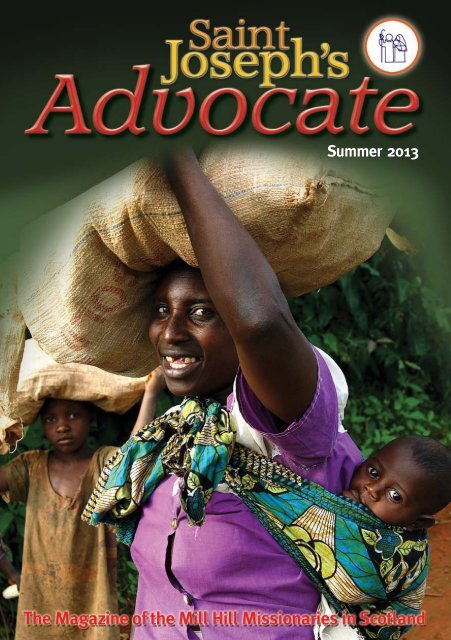

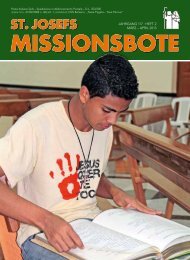
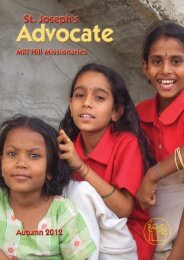
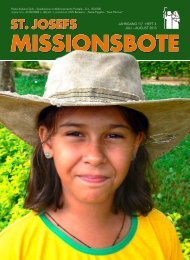

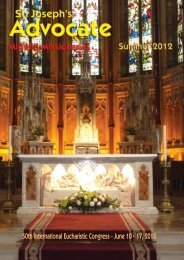
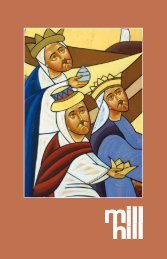
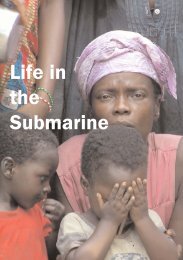
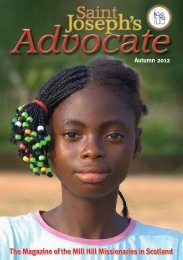

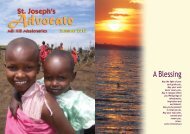
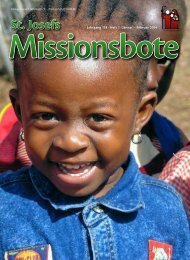
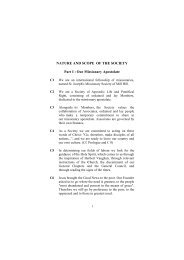

![Summer 2012 [pdf] - The Mill Hill Missionaries](https://img.yumpu.com/43011464/1/184x260/summer-2012-pdf-the-mill-hill-missionaries.jpg?quality=85)